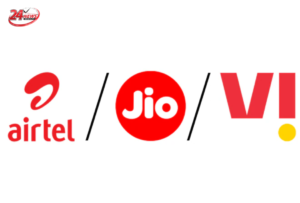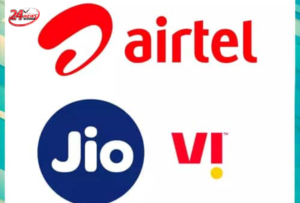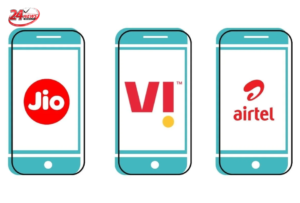Why Reliance Jio, Airtel and Vodafone Are Sending an SOS for 6GHz Spectrum
The telecommunication industry in India is abuzz with the recent news of three major players – Reliance Jio, Airtel, and Vodafone – sending an SOS to the government. The reason? The highly coveted 6GHz spectrum. This frequency band, which falls between 5.925 GHz and 7.125 GHz, is being sought after by these telecom giants for its potential to revolutionize the way we connect and communicate. But what exactly is 6GHz spectrum and why is it causing such a stir in the industry? Let’s delve deeper into this issue and understand why these companies are scrambling to secure their share of the 6GHz spectrum.
Understanding the Significance of the 6GHz Spectrum

The 6GHz spectrum is more than just a range of frequencies. It represents a major opportunity for the telecommunication industry in India to leap forward in terms of connectivity and communication. With its vast potential, telecom giants like Reliance Jio, Airtel, and Vodafone are sending an SOS to the government, urgently seeking their share of the 6GHz spectrum.
But why is it so important? The 6GHz spectrum has the ability to provide faster and more reliable internet speeds, improved network capacity, and support for emerging technologies like 5G and Internet of Things (IoT). It is a game-changer that has the potential to revolutionize the way we connect, communicate, and innovate in our digital world.
Why the Sudden Demand for 6GHz Spectrum?

The sudden demand for the 6GHz spectrum can be attributed to the incredible opportunities it presents for the telecommunication industry. Reliance Jio, Airtel, and Vodafone are all sending an SOS to the government to secure their share of this spectrum because they understand its game-changing potential. This frequency band can provide faster and more reliable internet speeds, increased network capacity, and support for technologies like 5G and IoT.
It’s a golden ticket for these telecom giants, enabling them to revolutionize the way we connect and communicate. With such promising benefits on the table, it’s no wonder that the sudden demand for the 6GHz spectrum has sent shockwaves through the industry. The race to secure this spectrum is on, and the implications for India’s digital transformation are enormous.
The Stance of the Telecom Giants

The telecom giants, Reliance Jio, Airtel, and Vodafone, have all sent an SOS to the government in their quest for the highly sought-after 6GHz spectrum. Their stance on this issue is clear – they understand the immense potential of this frequency band and the game-changing opportunities it brings.
These telecom giants are vying for their share of the 6GHz spectrum because they know that it can provide faster internet speeds, improved network capacity, and support for advanced technologies like 5G and IoT.
They are eager to revolutionize the way we connect and communicate in our digital world. With their collective stance, the telecom giants are sending a strong message to the government – the 6GHz spectrum is crucial for India’s digital transformation and they are determined to secure their place in this exciting future.
The Indian Government’s Response to the SOS

The Indian Government’s response to the SOS from Reliance Jio, Airtel, and Vodafone regarding the 6GHz spectrum has been eagerly anticipated. The government recognizes the immense potential and game-changing opportunities that this frequency band brings to the telecommunications industry in India. It understands the need for faster internet speeds, improved network capacity, and support for advanced technologies like 5G and IoT.
While the specific response from the government is yet to be determined, it is clear that they are aware of the importance of the 6GHz spectrum for India’s digital transformation. The telecom giants have made their case, and now it’s up to the government to make a decision that will shape the future of connectivity and communication in the country.
The Global Scenario and its Influence

In today’s interconnected world, the telecommunications industry is not just limited to one country or region. It operates on a global scale, with companies collaborating and competing across borders. So, when it comes to the highly coveted 6GHz spectrum, the global scenario and its influence cannot be ignored.
The demand for the 6GHz spectrum is not unique to India. Telecom giants around the world are also vying for their share of this frequency band. The implications of this global competition are twofold. Firstly, it increases the urgency for Indian telecom companies to secure their share of the spectrum to stay competitive on a global scale. Secondly, it highlights the potential for international collaboration and partnerships in utilizing the 6GHz spectrum for innovative connectivity and communication solutions.
The global scenario also plays a role in shaping regulations and policies surrounding the 6GHz spectrum. As governments and regulatory bodies observe the developments and demands of telecom giants worldwide, they will need to take a comprehensive approach to ensure fair and effective allocation of this valuable resource. Collaboration and coordination among countries will be essential to harmonize frequencies and create a global framework for utilizing the 6GHz spectrum.
Ultimately, the global scenario and its influence serve as a reminder that the race for the 6GHz spectrum is not just limited to India. It is a competition that spans borders, with the potential to shape the future of connectivity and communication on a global scale. As India’s telecom giants send an SOS to the government, they are also navigating a complex global landscape that will determine their place in the digital transformation of not just the country, but the world.
The Future Implications for India’s Digital Transformation

As the race for the 6GHz spectrum intensifies, the future implications for India’s digital transformation are immense. Securing their share of this highly coveted frequency band will enable telecom giants like Reliance Jio, Airtel, and Vodafone to unleash the full potential of connectivity and communication in the country. Faster internet speeds, improved network capacity, and support for advanced technologies like 5G and IoT will revolutionize the way we connect and communicate in our digital world.
This will not only benefit individuals and businesses but also accelerate India’s journey towards becoming a digitally advanced nation. The 6GHz spectrum is the key that will unlock a future where innovation and progress thrive, and India’s digital transformation becomes a reality. The implications are significant and far-reaching, impacting every aspect of our lives and propelling India to the forefront of the global digital revolution.
Conclusion
In the highly competitive telecommunication industry in India, the race for the 6GHz spectrum has reached a fever pitch. Reliance Jio, Airtel, and Vodafone have all sent an SOS to the government, recognizing the game-changing potential of this frequency band. The significance of the 6GHz spectrum lies in its ability to provide faster internet speeds, improved network capacity, and support for advanced technologies like 5G and IoT.
This is not just a local race; telecom giants around the world are also vying for their share of this valuable resource. The implications for India’s digital transformation are enormous. Securing their share of the 6GHz spectrum will unlock a future of innovation, progress, and connectivity. India has the opportunity to become a digitally advanced nation and lead the global digital revolution. The future is promising, and the stakes are high. The race for the 6GHz spectrum is on, and its outcome will shape the future of connectivity and communication in India and beyond.
ALSO READ : Breaking News: Skoda India Announces Price Hike for 2024


